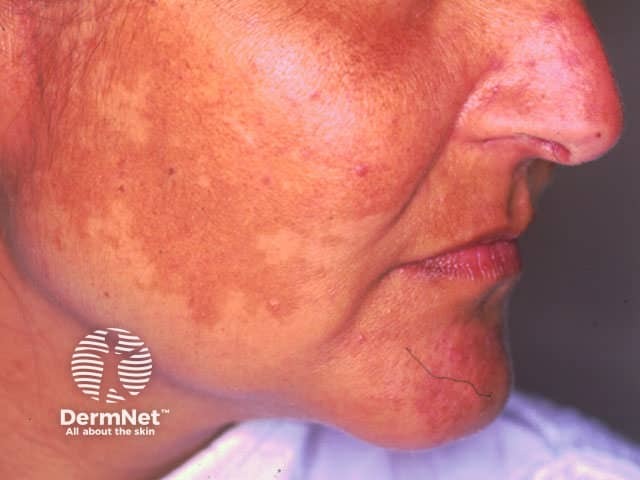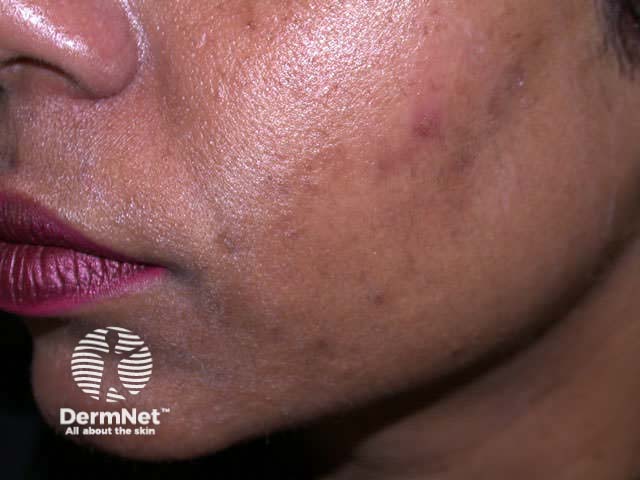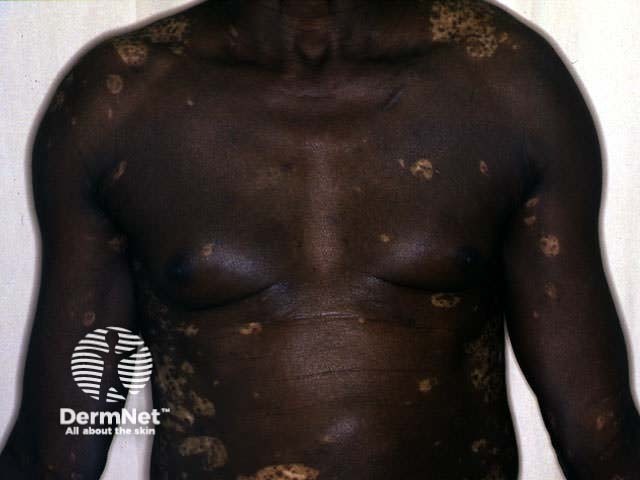Main menu
Common skin conditions

NEWS
Join DermNet PRO
Read more
Quick links
Ageing skin CME
Created 2008.
Learning objectives
- Distinguish intrinsic ageing from photoageing
- Revise basic physics and photobiology relating to ultraviolet radiation
- List Fitzpatrick skin phototypes and Glogau skin types
Introduction
Skin changes with age. Some of this is intrinsic and some is extrinsic ageing due to environmental exposure, mainly photoageing. Smoking and other pollutants also age the skin, causing delayed healing after injury and enhancing facial lines.
Intrinsic ageing results in thinning of the epidermis and dermis, structural defects and immunological failure. These features are exaggerated in photo-aged skin, accompanied by lines, colour changes and neoplasia.
Photoageing is due to the effects of ultraviolet radiation (UVR) on the skin. The influence of visible light or infrared radiation is comparatively minor unless thermal burns arise.
Ultraviolet radiation
UVR is arbitrarily split into UVC (200-290 nm), UVB (290-320nm) and UVA (320-400nm). UVA is further divided into UVAI (340-400 nm) and UVAII (320-340 nm). Solar UVC does not pass through the ozone layer so is not present on the earth's surface.
The electromagnetic spectrum 
UVR is at its greatest on the earth's surface when the sun is vertically overhead as it passes through thinner atmosphere than when the sun is at a greater angle. Thus:
- There is more UVR in Auckland than in Invercargill
- There is more UVR in summer than in winter
- There is more UVR at solar noon (1.30 pm in summer in NZ)
There is also greater total UV:
- When the conditions are clear, compared with cloud or smog
- With a reflective surface such as snow or sand
- On a mountain compared with at sea level
- Outdoors compared with behind window glass
Variation is greater for UVB than for UVA.
The global solar ultraviolet index (UVI) describes the level of solar UVR at the Earth's surface and ranges from 1 to 11+.
Measurements of UVR according to the time of day, Waikato Hospital 1989
UVR on clear day compared with cloudy day UVR in different seasons 

The biological effects of light on normal skin
UVR causes biological effects on various tissues when it is absorbed. Injury to nucleic acids results in abnormal structures such as cyclobutane dimers and adducts. There are several repair mechanisms in normal individuals but their malfunction results in the development of aging changes and skin cancer.
The acute response of the skin to exposure to UVR has rapid onset (minutes to days) and short duration (hours to weeks).
- Erythema (sunburn)
- Immediate pigmentation (due to UVA and visible light in darker skin types)
- Delayed pigmentation (suntan)
- Vitamin D production from precursors
- Skin thickening
Erythema mainly results from UVB i.e. wavelengths <320nm. It arises from dilation of the superficial blood vessels produced by cytokines. Solar-induced erythema is delayed by a few hours after exposure. Delayed tanning is noticeable two days after exposure and most intense a week afterwards. It is due to melanogenesis and distribution of melanin to keratinocytes throughout the epidermis. UVA and even visible radiation may cause melanogenesis, but UVB is the most effective in initiating it.
Further exposure to UVR causes less damage:
- Melanin absorbs the UVR preventing it from reaching lower layers of the skin;
- Epidermal keratinocytes proliferate so the skin becomes thicker (acanthosis).
UVB converts precursors in the skin into vitamin-D. The liver, then the kidneys, change vitamin-D into calcitriol (1,25 dihydroxycholecalciferol), which is required for calcium homeostasis.
Skin cancers are due to progressive mutations in DNA. They are induced by:
- UVB definitely
- UVA probably
- Injury, sometimes.
Skin phototypes
Fitzpatrick skin phototypes 1 to 6 are used to classify the effect of sun exposure on an individual's skin. Types 1 and 2 are at high risk of skin cancer, particularly when exposed to intense sunlight.
| Type 1: | Very fair. Burns easily, doesn't tan |
| Type 2: | Fair. Burns easily, tans lightly |
| Type 3: | Olive. Burns somewhat, tans readily |
| Type 4: | Light brown. Burns rarely, tans well |
| Type 5: | Dark brown. Doesn't burn, tans deeply |
| Type 6: | Black |
Type 1 Type 2 Type 3 Type 4 Type 5 Type 6 





Immune response
UVR results in profound alterations of both local and systemic immune responses:
- The immune changes are mainly mediated by cytokines released from epidermal cells, but also by neuropeptides released from sensory nerves in the skin;
- The function of antigen-presenting cells (Langerhans's cells) is reduced;
- UVR prevents primary contact sensitisation to surface antigens;
- It inhibits histamine release from mast cells;
- Suppressor T cells may induce tolerance contributing to eventual development of skin cancers.
Chronic response to exposure to UVR
Sun damage (photoageing) includes:
- Dry coarse leathery appearance
- Loss of skin elasticity
- Fine wrinkles
- Dilated capillaries and easy bruising (senile purpura)
- Thin, transparent, fragile tissue
- Freckles and lentigines
- Actinic keratoses
- Skin cancer (melanoma, basal cell carcinoma, squamous cell carcinoma)
Signs of photoageing
Thin transparent and wrinkled skin Furrows due to muscle movement Freckles and lentigines Senile purpura 



Glogau skin types
Glogau skin types refer to the degree of photoageing:
- Mild (age 28-35 years): Few wrinkles, no keratoses
- Moderate (age 35-50 years): Early wrinkling, sallow complexion with early actinic keratoses
- Advanced (age 50-60 years): Persistent wrinkling, discolouration of the skin with telangiectases and actinic keratoses
- Severe (age 65-70 years): Severe wrinkling, photoaging, gravitational and dynamic forces affecting skin, actinic keratoses with or without skin cancer
Activity
Determine Fitzpatrick skin phototype in 20 patients over 60 years of age. Compare this to their Glogau skin type.
References:
- Australian Regulatory Guidelines for OTC Medicines. Chapter on Sunscreens, 24 September 2003. (pdf)
On DermNet:
Information for patients
Other websites:
- National Institute of Water and Atmospheric Research
- Ministry for the Environment
- New Zealand Climate Change Office
- Electronic Textbook of Dermatology: Sunscreens
- Standards New Zealand: input the keyword ‘sunscreen’ to locate 2604:1998(AS/NZS) Sunscreen products – Evaluation and classification (NZ$62.44+GST)
- Australian Photobiology Testing Facility
Books about skin diseases:
See the DermNet bookstore
